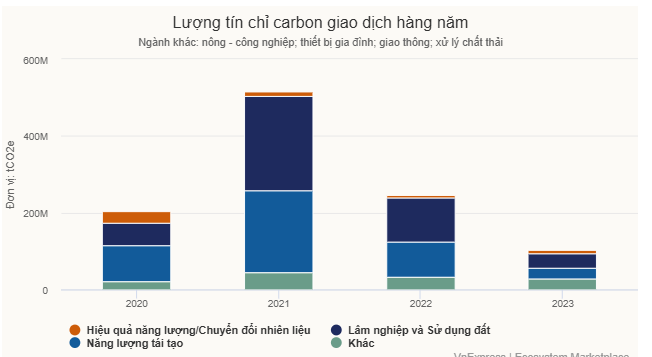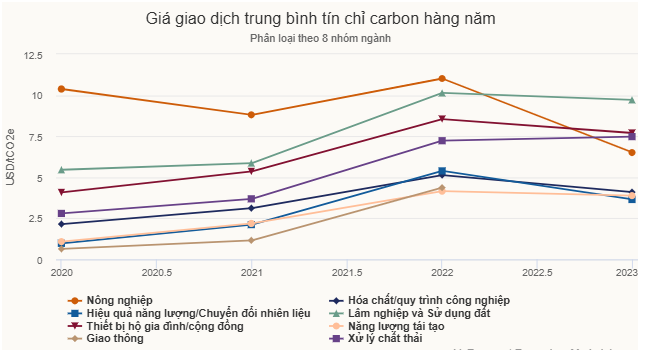Forestry emerges as the leading sector in Vietnam's carbon credit market, with a significant contribution of 10.3 million credits traded through the World Bank.This is followed by wind power and biogas.
A carbon credit is a permit allowing an entity to emit a specified amount of greenhouse gases, principally carbon dioxide (CO2). One credit equates to one metric ton of CO2 emissions.
Which sector in Vietnam is the largest generator of carbon credits?
Currently, Vietnam has 116 registered projects undergoing registration, verification, or certification processes for carbon credits, based on data from Gold Standard and Verra. Among these, 40 projects have been certified, collectively issuing 10.7 million credits annually.
In a sectoral breakdown, forestry, with a single project, stands out as the top generator of annual carbon credits. This is also Vietnam's largest carbon credit project, selling 10.3 million forest carbon credits (equivalent to 10.3 million tons of CO2) through the World Bank. Valued at $5 per ton, the project generated a revenue of $51.5 million, approximately 1,200 billion VND.
The calculated emission reductions cover the period from February 2018 to December 2019, indicating an average annual sale of nearly 5.4 million carbon credits from this project.
Potential sectors for carbon credit generation
According to Ecosystem Marketplace, a platform for environmental markets, there are approximately 170 types of projects that can generate carbon credits, categorized into 8 main groups:
-
Forestry and Land Use: includes nature-based solutions (except those implemented on agricultural and grassland lands). Forestry projects generate carbon credits through emissions reductions from avoided deforestation and improved forest management, or through the removal of CO2 from the air by converting it into biomass as new vegetation grows.
-
Renewable energy: projects mitigate emissions through the substitution of fossil fuels with renewable energy sources such as wind, solar, hydro, geothermal, and biogas.
-
Agriculture: projects concentrate on sustainable land management, including carbon sequestration in soils and methane emissions reduction from livestock and cultivation.
-
Industrial processes: focus on eliminating or minimizing greenhouse gas emissions generated or utilized within industrial operations.
-
Energy efficiency and fuel switching: projects decrease fossil fuel consumption by enhancing industrial processes and civil and commercial heating and lighting systems, as well as transitioning from fossil fuel-based power and heat generation to biomass or lower-carbon fuels like natural gas.
-
Transportation: projects aim to reduce emissions by improving transport system efficiency, including developing new systems such as public transport and electric vehicles.
-
Waste management: projects mitigate greenhouse gas emissions through the capture and disposal of methane from organic material decomposition (excluding methane used for heat or power generation), recycling of materials to avoid emissions from new production, and organic composting to prevent methane formation.
-
Household and community: projects focus on reducing carbon emissions at the household or community level, encompassing energy-efficient cookstoves and water filters, community energy efficiency improvement projects, and the construction of biogas infrastructure for non-fossil fuel-based heat and cooking in rural communities.

Source: VnExpress
The eight sectors that can generate the largest amounts of carbon credits today are forestry and renewable energy.
Carbon credit pricing across sectors

Source: VnExpress
The forestry and land use sector has emerged as the dominant player in the carbon credit market, commanding the highest trading price at an average of $9.72 per credit in 2023. This price has exhibited a steady upward trend over the past four years, from $5.46 per credit in 2020.
Renewable energy projects, while being the second largest contributor of carbon credits to the market, have consistently traded at lower prices, averaging $3.88 in 2023, marking a slight improvement from $1.08 in 2020.
Price differentials in Carbon credits
-
Despite all carbon credit projects contributing to sustainable development, they offer distinct benefits. Investors often gravitate towards credits that not only mitigate emissions but also deliver direct social impacts.
-
The substantial price disparities among different project types can be attributed to varying implementation costs.
Enterprises are willing to pay a premium for forestry carbon credits due to their profound influence on conservation and community well-being. Moreover, forestry projects are more readily communicated and substantiated through visual representations and detailed impact reports, enhancing a company's reputation. As a result, forestry carbon credits have maintained the most stable and highest prices.
Vietnam is reinforcing its position in the global carbon credit market with the forestry sector playing a pivotal role in generating carbon credits, thereby contributing to both environmental conservation and economic growth.
Contacs
GIANT BARB SCIENCE AND ENVIRONMENT JOINT STOCK COMPANY
📞 Hotline: +84 995 206 666
✉️ Email: info@giantbarb.com
🏢 Headquarter: No.07 Ton That Thuyet, Dich Vong Hau ward, Cau Giay district, Hanoi